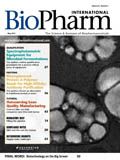Supply Chain Pain
Addressing supply-chain challenges.
The tragic earthquake and tsunami in Japan in March rocketed supply-chain issues to a prominent position. Even the most sophisticated supply-chain managers were caught off guard by the event, which caused the shutdown of many manufacturing sites due to earthquake damage or power-supply interruptions. What is striking about the impact of the Japan earthquake on the supply chain is the widespread production disruptions caused by supply interruptions of simple components. Automobile manufacturers were forced to shut down manufacturing operations around the world due to component shortages. Production of Apple's iPad2 was threatened by the shutdown of a supplier in northeastern Japan making a connector costing just a few cents.

Jim Miller
The automobile and electronics industries are known for their supply-chain sophistication, including their ability to source components globally and have them delivered just-in-time to the manufacturing floor. The fact that their production would be disrupted by such minor components speaks to just how complex effective supply-chain management really is.
BIO/PHARMA INDUSTRY VULNERABILITY
Reports so far suggest that the bio/pharmaceutical supply chain has only been marginally affected by the events in Japan. We have heard of only two interruptions. One was from a supplier of glycine, an ingredient in some common solid-dosage products, which indicated that production may be shut down for up to 24 months. We also heard of disruptions in some supplies of gelatin used in softgel capsules, for which alternative suppliers are readily available.
Nevertheless, the bio/pharmaceutical industry has not been without its own supply-chain difficulties in recent months. A major fire destroyed a warehouse attached to Catalent's commercial packaging facility in Corby, UK, and problems stemming from glass-vial delamination resulted in a recall of many injectable products.
The pharmaceutical industry has done surprisingly little to protect itself from supply-chain interruptions. PharmSource recently conducted a survey about a widely used component for solid-dosage drugs, which typically requires preformulation compatibility testing, and found that few companies have exhibited the foresight to qualify second or third suppliers.
For component-assembly industries, such as automobiles or electronics that are relatively unregulated, the interruption in the supply of a minor component will be disruptive and relatively short-lived. In most cases, it could be a matter of weeks to redesign the component or have substitute suppliers step in for secondary supply. In the bio/pharmaceutical industry, however, the long-term interruption of a minor component could be catastrophic. Even a relatively minor excipient can cause changes in a product's characteristics, thereby requiring full preformulation analysis, stability testing, and testing of production batches. Add to that the supplier qualification and regulatory-filing requirements, and the production time lost can be considerable.
INADEQUATE SUPPLY-CHAIN PRACTICES
The bio/pharmaceutical industry's lack of supply-chain sophistication spans the entire length of the chain, from input sourcing, through production and inventory management, to distribution. At the front end of the chain, we need only be reminded of the heparin disaster of a few years ago to appreciate the weaknesses in quality assurance and supplier management for key inputs. At the distribution end of the supply, the bio/pharmaceutical industry has been under attack regarding counterfeiting and security of supply. A recent article in Fortune magazine recounted last year's theft of $75 million of finished drug product from an Eli Lilly warehouse in Enfield, Connecticut (1). The article highlighted the lax security at the warehouse, including failure to monitor security cameras that could have caught the theft while it was taking place.
Supply-chain management weakness also can be seen in the way the industry manages its inventories. On average, global bio/pharmaceutical companies turn their inventories a little more than twice a year. They typically have inventory on hand equivalent to about 180 days' worth of sale. By contrast, a best-practice consumer products firm, such as Procter and Gamble, turns its inventory about six times a year and has about 60 days' worth of inventory on hand. As global bio/pharmaceutical companies try to maximize their cash-on-hand to help weather the patent cliff and take advantage of licensing and acquisition opportunities, keeping so much cash tied up in inventory is a competitive disadvantage.
OPPORTUNITY FOR CONTRACT SERVICES
The supply-chain management challenges facing the industry represent a major opportunity for providers of contract services, especially those in manufacturing and packaging. Because of their critical position relative to both the upstream and downstream segments of the supply chain, CMOs and packagers are well positioned to help bio/pharmaceutical companies manage their risk and squeeze cost and inventory out of the system.
We have seen isolated instances of contract-service providers responding to supply-chain management opportunity (e.g., Patheon's recent efforts to promote its services as a backup source of supply and Almac's short-run packaging services). We've also seen major providers of third-party logistics services (3PL), such as UPS, make greater efforts to address the bio/pharmaceutical industry.
However, the big opportunity will come when service providers figure out how to increase the flexibility and responsiveness of their own operations. For instance, every day that a CMO can knock off the manufacturing schedule lock-in requirement from its traditional three months can save its bio/pharmaceutical company clients millions of dollars in cash tied up in inventory. The internal process changes necessary to achieve those scheduling improvements are likely to deliver substantial cost savings and increased throughput. CMOs have traditionally focused on additions to processing technologies, equipment and gain-to-gain incremental volume. Given the growing supply-chain challenges, a focus on operations excellence in the context of supply-chain management is likely to yield greater performance for both the client and CMO and yield market share gains going forward.
Jim Miller is president of PharmSource Information Services, Inc., Springfield, VA, 703.383.4903, jim.miller@pharmsource.com.
REFERENCE
1. K. Eban, Fortune, Mar. 31, 2011, http://features.blogs.fortune.cnn.com/2011/03/31/drug-theft-goes-big/.

Thermo Fisher Opens Advanced Therapies Collaboration Center in California
April 18th 2025The 6000-square-foot facility will provide cell therapy developers the support they need to transition to CGMP manufacturing, and an expanded footprint of the new center is expected to open in Philadelphia later in 2025.